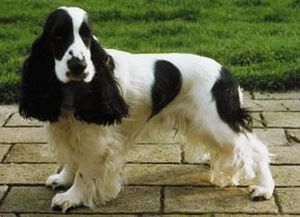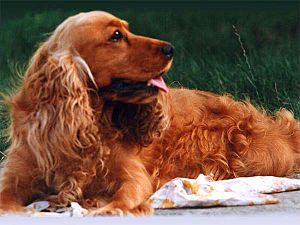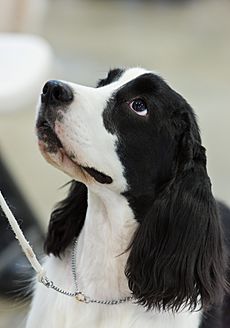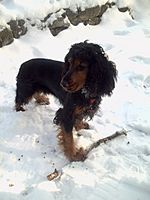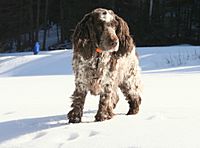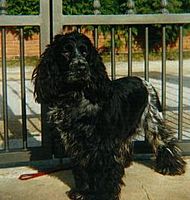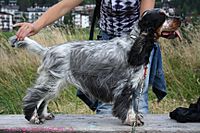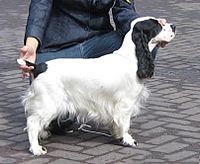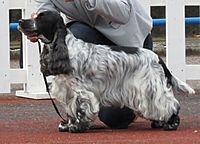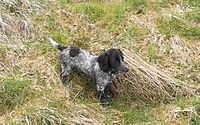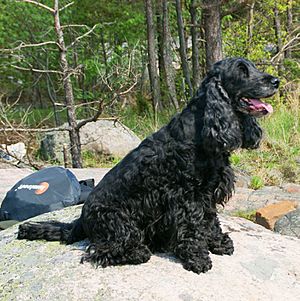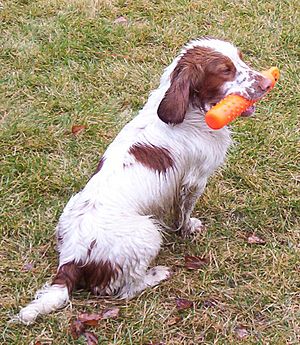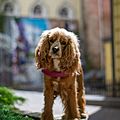English Cocker Spaniel facts for kids
The English Cocker Spaniel is a type of dog breed. It's one of many Spaniel breeds. Spaniels were first bred to help hunters. They would find and bring back animals that had been shot. Today, many English Cocker Spaniels are loving pets. They are still very active and smart dogs. Most of them are happy, friendly, and intelligent animals.
English Cocker Spaniels make great family pets. They don't like to be left alone for too long. If they are, they might make noise or chew on things. These dogs are loyal and love to be with people. They like to sit close to their owners. They want to be together as much as possible. English Cocker Spaniels are very smart. They are ranked 18th in a book called The Intelligence of Dogs by Stanley Coren.
English Cocker Spaniels are known for being happy. They wag their tails a lot! Because of this, people sometimes call them "merry cockers." They can be strong-willed but are very loyal to their family. English Cocker Spaniels come in many different colors. They usually stand about 38 to 41 cm tall. They weigh between 11 and 13 kg.
Contents
History
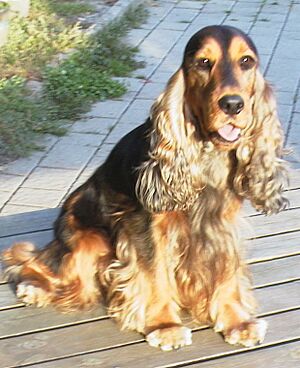
Dogs that look like Spaniels have been seen in art and books for almost 500 years. At first, spaniels in England were grouped into two types: land spaniels and water spaniels. The different spaniel breeds we see today started to appear in the mid-1800s. Back then, land spaniels became more specialized. They were divided by their weight. In 1840, a book said that Cockers weighed between 5.5 and 9 kg.
It was common for Cocker and Springer puppies to be born in the same litter. Even a small "Toy" sized puppy could grow up to be a Springer. Early records don't show spaniels bringing back game. Instead, they were used to chase animals towards the hunters.
In the 1850s and 1860s, other types of Cockers appeared. These included Welsh Springer Spaniels and Devonshire Cockers. Also, small dogs from Sussex Spaniel litters were called Cockers. In 1874, the first official dog records were made by the new kennel club. Any spaniel under 11 kg was called a Cocker. However, the Welsh Cocker was later called a Springer in 1903 because it was larger and had shorter ears.
Dog shows became popular after The Spaniel Club started in 1885. At first, new Springer and Cocker dogs were shown in the same group. Then, The Spaniel Club made special rules for each type. The Kennel Club officially separated the two types eight years later. Since then, people who love Springers and Cockers have bred them to have different features. Today, the breeds are different in more ways than just weight.
The English Cocker Spaniel has won the "Best in Show" award at Crufts many times. Crufts is a very famous dog show. They won seven times between 1928 and 2009. Three of these winners came from H.S. Lloyd's Ware kennel. Because of World War II, the English Cocker Spaniel was the only breed to win between 1938 and 1950. The most recent winner was Sh. Ch. Canigou Cambrai in 1996.
Field Spaniel
In the late 1800s, dog shows became very popular. This led to many new spaniel breeds. Some dog lovers decided to create a large black spaniel breed. Four dogs were used to start this new breed. Two were Cocker Spaniels. One was a mix of Cocker Spaniel and English Water Spaniel. The last one was a Norfolk Spaniel. This new breed was called the Field Spaniel. It was officially recognized by the Kennel Club in 1892.
American Cocker Spaniel
The American Cocker Spaniel came from the English Cocker Spaniel. This happened in the 1800s in America. They were bred to find birds like quail and woodcock. At first, they were only separated from English Cockers by size. But over the years, they were bred for different traits. The two Cocker Spaniels were shown together in America until 1936. That's when the English Cocker became its own separate breed. The American Kennel Club officially recognized the English Cocker Spaniel as a separate breed in 1946.
The American Cocker Spaniel has a shorter nose. It is also more likely to get ear infections. Its fur is groomed differently from the English Cocker.
Description
The English Cocker Spaniel is a strong, compact, and well-balanced dog. It has a special look that shows it is smart and alert. Its eyes should be dark. Its long, floppy ears should reach past the tip of its nose when pulled forward. Today, there's a big difference in how "field-bred" (working) and "show-bred" dogs look.
In North America, a Cocker's tail is usually shortened. This is called docking. In places where docking is allowed, the tail is usually about 10–13 cm long for working dogs. Show dogs usually have their tails docked much shorter. Docking is now against the law in Australia, South Africa, and Scotland. In England and Wales, tails can only be docked if the dog will be used for working or hunting.
Male English Cocker Spaniels are usually between 39 and 41 cm tall at the shoulder. Females are a little smaller, between 38 and 39 cm. Both males and females weigh about 13–14.5 kg. American Cocker Spaniels are smaller. Males are usually between 36 and 39 cm tall. Females are between 34 and 37 cm. Both American Cockers weigh about 11–13 kg. The English Springer Spaniel is larger than both types of Cockers. Female Springers are 48–50 cm tall, and males are 49–51 cm. They weigh between 23 and 25 kg.
The English Cocker Spaniel looks a lot like the English Springer Spaniel. At first glance, the main difference is that Springers are bigger. But English Cockers also have longer ears that are set lower on their heads. Springers tend to have a longer nose. Their eyes are not as big, and their fur is not as thick.
Color
Rules for dog shows limit the colors that dogs can be. This depends on the country. But working Cockers can be many different colors. For example, in the United Kingdom, the Kennel Club says that solid colored dogs cannot have any white fur, except on their chest.
English Cockers come in solid colors, "particoloured" (meaning two or more colors), and "roan" types. Roan means they have solid patches and white patches. The white patches have speckles of the same color as the solid patches.
The colors include black, liver (brown), red, golden, sable, silver, ash, black and tan, and liver and tan. They also come in blue roan, liver roan, orange roan, and lemon roan. Some have black and white, liver and white, orange and white, or lemon and white markings.
Sable is a rare solid color. Some countries consider it a particolour because its hairs are mixed. White with black or brown spots is also rare. It is usually seen as a particolour too. A silver or ash color is possible but has not been officially recorded in the UK. Lemon roan with light brown spots is the most rare roan color. All-white Cockers are rarely born. They are thought to be more likely to be deaf. So, they are not usually encouraged in the breed.
Temperament
Cockers are caring, determined, kind, and smart dogs. They are also athletic, alert, and strong. They make wonderful family pets. This breed does not like to be alone. They will bond very strongly with one person in the family. This is usually the person who feeds them. They are known for being happy, smart, and able to adapt. The breed is extremely loyal and loving.
The English Cocker Spaniel has a cheerful personality. They are ranked 18th in Stanley Coren's The Intelligence of Dogs. This means they are very good at learning and obeying commands. Because they are so happy and wag their tails all the time, they are called "merry cockers." They can also be a bit bossy but are very loyal to their family.
If they are socialized well when they are young, Cocker Spaniels get along with people, children, other dogs, and other pets. This breed always seems to be wagging its tail. They prefer to be around people. They are not suited to being left alone in a backyard. Cockers can get stressed easily by loud noises or by rough handling. If you train them gently and give them lots of rewards, the Cocker Spaniel will be an obedient and loving friend with a happy nature.
Health
English Cocker Spaniels in the UK, USA, and Canada usually live for 11 to 12 years. This is a normal lifespan for purebred dogs. It's a little less than most other breeds of their size. The English Cocker Spaniel usually lives about a year longer than the smaller American Cocker Spaniel.
Common health problems for English Cockers include bite issues, skin allergies, shyness, and eye problems like cataracts. They can also have deafness, which affects about 6.3% of the breed. Some may show aggression towards other dogs. They can also get harmless tumors.
Working Cockers
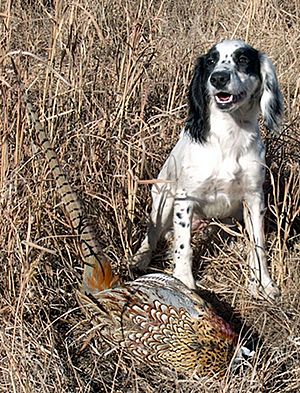
This breed, like many others that started as working dogs, has two main types. Some lines of dogs are bred for their skills as working dogs. Other lines are bred to look exactly like the breed standard for dog shows. These are called "working" (or "field-bred") and "conformation" (or "show") types. After World War II, Cocker Spaniels bred as pets and for dog shows became very popular. For a while, they were the most common breed registered with the Kennel club. This made some people think that all Cockers were not good working dogs. But this is not true for most dogs. Even some show-bred Cockers still have their hunting instincts.
Today, this breed is becoming popular again as a working and hunting dog. Working dogs look different from show dogs. Like the English Springer Spaniel, the working type has been bred only to perform in the field as a hunting partner. Their fur is shorter, and their ears are not as long as the show-bred type. Even though they are the same breed, the two types have become so different that they are rarely bred together. The dogs that are best at hunting tests and trials in the United States are field-bred dogs from English lines. Working dogs often have physical traits that would prevent them from winning in dog shows. This is because they are bred for different skills than show dogs. Long fur and ears, which are good for shows, can get in the way when hunting. Cuban authorities even train English Cocker Spaniels to be sniffer dogs. They check for drugs or food in bags at airports.
Skills
A field-bred cocker spaniel is mainly a dog that flushes (or scares up) birds in open fields. To do this job well, the dog must be trained in certain skills.
- Hup This is the command to sit and stay. To be a good hunter, the dog must obey this command perfectly. When the dog "hups," the handler can tell it where to go. Being able to "hup" a dog that is actively working helps the hunter keep up without running.
- Retrieve to Hand Most hunters and all judges in hunting tests want a dog to bring the bird directly to their hand. This means the dog holds the bird until told to give it to the hunter.
- Quarter Dogs must search for birds in a pattern in front of the hunter. The dog must learn to stay close enough so the hunter can shoot the bird.
- Follow Hand Signals Hunting birds involves chasing wild game in their natural home. Hunting dogs must check likely hiding spots for birds. The dog must respond to hand signals so the hunter can guide it into specific areas.
- Steady When hunting birds, a flushing dog should be "steady to wing and shot." This means it sits down when a bird flies up or a gun is fired. It does this to remember where the bird fell. It also stops it from flushing other birds while chasing a missed one.
Trivia
Prince William and Catherine, Princess of Wales own an English Cocker Spaniel named Lupo. Lupo was born from Ella, a dog owned by Catherine's parents. Lupo is a working-type English Cocker Spaniel. He was born just before Christmas in 2011. Prince William and Catherine first didn't tell the media they owned him.
After Prince George was born, Lupo was in one of the first official photos. He was later in a family picture with Prince William, Catherine, and Prince George in March 2014. He traveled with his owners to their holiday home in Norfolk. However, he did not go with them on their trip to Australia and New Zealand in 2014.
Related pages
Images for kids
See also
 In Spanish: Cocker spaniel inglés para niños
In Spanish: Cocker spaniel inglés para niños


